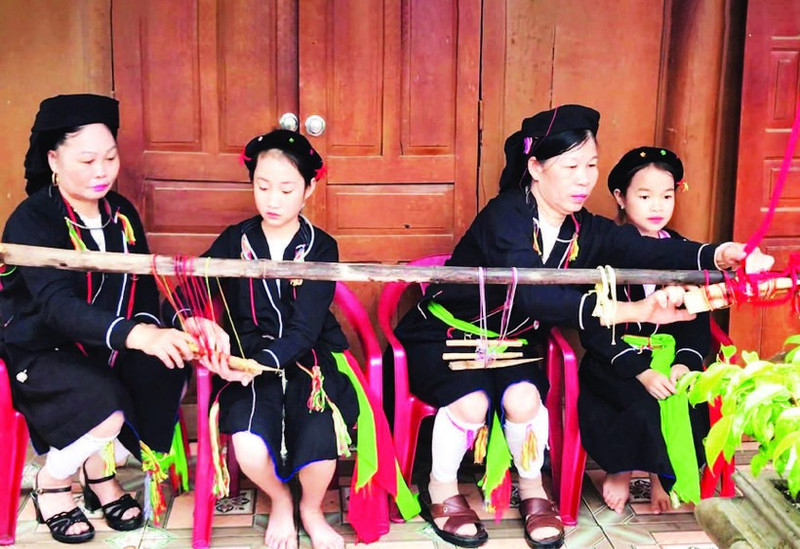Preservation of traditional handicrafts
For generations, traditional handicrafts such as weaving and brocade embroidery have been deeply intertwined with the lives of ethnic minority communities in Tuyen Quang Province, serving not only as a means of livelihood but also as a distinctive cultural identity.

However, as modern production techniques have become increasingly widespread in making daily-use items, traditional crafts have gradually fallen into decline. Faced with this reality, many localities across the province have been striving to revive and pass on these crafts to younger generations, with the aim of preserving and promoting the cultural values of their ethnic heritage.
Bamboo and rattan weaving has long been a traditional craft closely associated with the Tay ethnic community in Tan My commune. Yet over time, as industrial products have become more widespread, this age-old craft now faces the risk of fading into oblivion.
With the desire to preserve it, the Tan My Bamboo and Rattan Cooperative was established with 12 members. The cooperative serves both as a place where generations come together to maintain their cultural heritage and as a workshop producing handicrafts for markets within and beyond the province. This not only generates income for its members but also helps to preserve the cultural identity of the Tay ethnic group.
Hoang Thi Hoan, head of the cooperative, shared that bamboo and rattan weaving not only provides her family with additional income but also spark the desire to protect and develop the traditional craft. Inspired by this, she proposed forming the cooperative so that members could jointly develop the weaving tradition.
Her proposal quickly gained the support of local Party committees and authorities. Taking advantage of available natural materials, and making use of their spare time during the farming off-season, members of the cooperative wove traditional products of their ethnic community such as baskets, bags, and conical hats. These items were sold at local markets as well as promoted and marketed through social media platforms.
However, according to Hoan, the cooperative’s products remain largely small-scale and unstable in price. “In the future, the cooperative intends to recruit more members and focus on training young people, helping to preserve and develop traditional crafts in line with ethnic identity. We will actively participate in fairs and trade promotion events to expand our markets and gradually establish a foothold for local bamboo and rattan products,” she said.
For San Diu women in Son Thuy Commune, their traditional costume is simple yet exudes strength, neatness, and individuality.
Passing down a love for traditional attire and brocade weaving techniques to the younger generation has always been a priority for the San Diu community. At weekends, skilled artisans gather to teach children how to weave brocade sashes. For these youngsters, learning to weave is not only an expression of their fondness for a handicraft but also a responsibility to preserve their heritage, ensuring that the identity of their people is not lost.
Truong Bao Thi, a girl from Cay Da 1 Hamlet, Son Thuy Commune, shared: “At first it was difficult, but thanks to the patient guidance of my grandmothers and aunts, I have learned to weave sashes and embroider skirt patterns. I feel very proud to be able to create traditional products of my ethnic group.”
According to Do Thi Man, also from Cay Da 1 Hamlet, at the beginning, the children found weaving and embroidery quite challenging. But they learned quickly; after only three to four days, they could already finish a sash. Teaching them in this way helps preserve and transmit our ethnic cultural identity to the next generation.
Meanwhile, Hung Thi Trang, over 70 years old and an ethnic Pa Then from Thuong Minh Hamlet, Minh Quang Commune, is one of the few elders still preserving and passing on brocade weaving. Despite her age, her woven patterns remain sharp and intricate, reflecting her skill and dedication. Today, she not only teaches her children and grandchildren but also instructs 20 women in the hamlet in Pa Then weaving.
She explained that in the past, Pa Then patterns typically depicted images of bridges, houses, and lozenges. Today, Pa Then women create new motifs, but still retain the traditional ones rich in cultural identity.
Sin Thi Lan, from Thuong Minh Hamlet, said that thanks to Trang’s classes, she has learned to weave the Pa Then women’s traditional costume for herself, as well as embroider additional sets to sell to tourists at prices of 3-5 million VND each. Furthermore, during tourism promotion programmes and local cultural events, Pa Then art clubs are given opportunities to perform in traditional costumes, thereby promoting their cultural identity to visitors from inside and outside the country.
The preservation and development of traditional handicrafts not only helps protect national cultural values but also creates livelihoods for ethnic communities. Dedicated figures such as Hoan, Man, and Trang are keeping the flame alive for younger generations, nurturing pride in their cultural identity. When culture is tied to sustainable livelihoods, it forms a foundation ensuring that traditional values are not forgotten but continue to spread far and wide.








